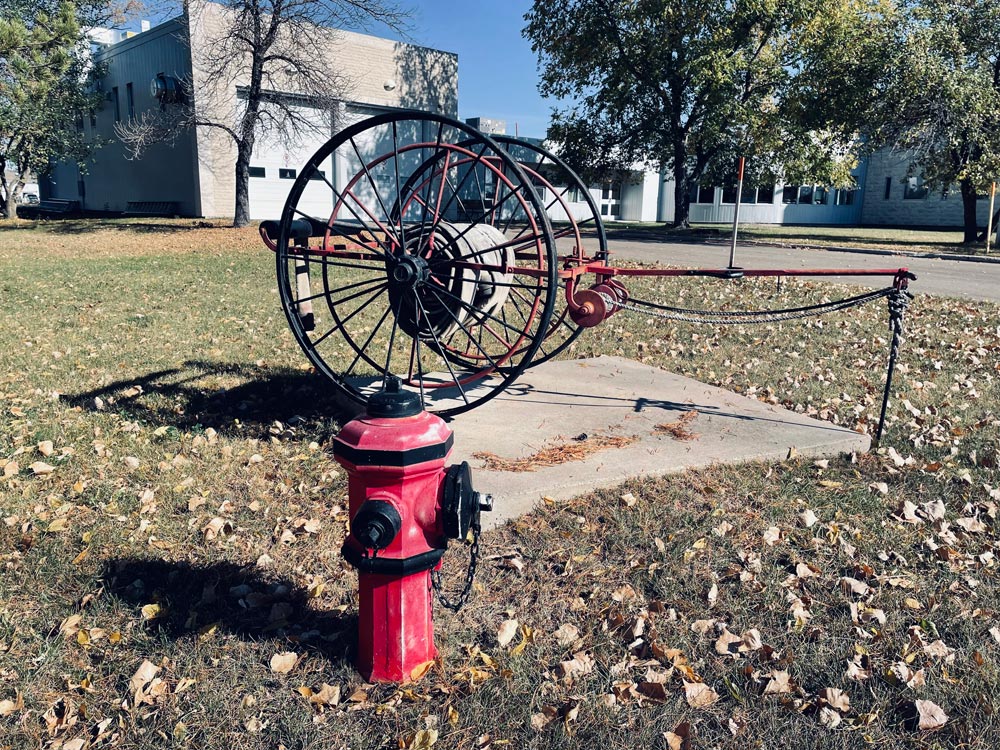
This year is the 100th anniversary of Fire Prevention Week. Recognized across North America each year, Fire Prevention Week campaigns work to educate people about the simple, but important actions they can take to keep themselves and those around them safe. Here’s a view of the Base’s fire department on a quiet Friday morning. Photos Jules Xavier/Shilo Stag

Stag Special
As we approach Fire Prevention Week running from Oct. 9 to 15, CFB Shilo’s Fire and Emergency Services would like to urge all Base residents to take this year’s theme to heart: “Fire Won’t Wait. Plan Your Escape!”
This year is the 100th anniversary of Fire Prevention Week. Recognized across North America each year, Fire Prevention Week campaigns work to educate people about the simple, but important actions they can take to keep themselves and those around them safe.
Here are a few safety tips:
* Make a home fire escape plan that includes two ways out of every room. Make sure everyone in your home is part of the plan;
* Make an outside meeting place that is a safe distance from your home;
* Ensure all smoke alarms in your home are working;
* If the smoke alarm sounds, get out and stay out;
* Call 9-1-1 from outside your home.
Meanwhile, Fire Prevention Week is a fun time with activities planned and helpful tips and reminders. It is good to be fire safe to prevent fires and prepare just in case a fire does occur. However, we need to remember that fire can be very dangerous.
Fire Prevention Week: Lithium Ion Batteries
The Office of the Canadian Forces Fire Marshal is seeing an increasing number of incidents implicating Lithium ion batteries.
Lithium ion batteries supply power to many kinds of devices, including smartphones, laptops, hoverboards, scooters, e-bikes, e-cigarettes, smoke alarms, and toys. These batteries must be handled carefully.
In rare instances, they can cause a fire or explosion.
For your safety
Purchase and use devices that are listed by a qualified testing laboratory.
Always follow manufacturer’s instructions that come with the device and only use the battery that is designed for the device. Batteries should be placed in the device the right way and only use the charging cord that came with the device.
A device should never be charged under your pillow, on your bed, or on a couch. Excessive charging should be avoided. Constantly charging a device can reduce the battery’s life or cause the battery to stop working. Remove the battery from its charger after it is charged.
Lithium ion batteries should be kept at room temperature and never in direct sunlight, near open flames or left in hot vehicles.
Avoid using a device in a highly damp or humid environment.
Lithium ion batteries should always be away from anything that can catch fire. Physical impact such as crushing, bending, or dropping should also be avoided.
Stop using the lithium ion battery/device if you notice odour, leaking fluids, change in colour, excessive heat, change in shape (puffy), sparking, or smoke.
Inspect the batteries prior to usage, if they are damaged, remove them from service and dispose of them safely and in accordance with your local disposal instructions.
Safe storage
Store lithium batteries and devices in dry, cool locations. When storing the item, remove the lithium ion battery and place in fire resistant storage bags, if possible. Inspect batteries when they are first installed and after charging for any signs of damage, and do not recharge damaged lithium ion batteries.
Charing hoverboards scooters and e-bikes
An adult should be responsible for charging a hoverboard, scooter and e-bike, and the charging should never be left unattended, nor should they be left plugged in overnight. Stop using the hover board, scooter or e-bike if it overheats.
Disposal
Do not put lithium ion batteries in the trash, and do not put discarded lithium ion batteries in piles. Recycling lithium ion batteries is always the best option. Take lithium ion batteries to a recycling location or contact the Wing environmental officer for disposal instructions.
In case of a small fire, call 911. If possible, a class D or ABC Dry chemical powder extinguisher can be used to douse the flames.
If you have further questions or queries regarding lithium ion batteries, contact the Office of the Canadian Forces Fire Marshal at luc.page@forces.gc.ca

